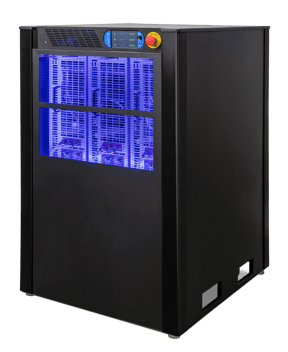Renewable energy continues gaining momentum. Of the 2.7% increase in U.S. electricity sales in 2022, nearly all of it came from solar and wind sources, according to the U.S. Energy Information Administration (EIA). The organization estimates that renewable sources provided 22% of U.S. generation in 2022 and will provide 24% in 2023.1
Solar, wind, and other renewable energy systems have one component in common—an inverter. On the DC side is a solar-panel array, the rectified output of a wind turbine, a fuel cell, or a battery bank previously charged by a renewable source. On the AC side is the grid. Before being put into service, the inverter must be thoroughly tested for functionality, reliability, and compliance with relevant standards.
Surround the inverter

AMETEK Programmable Power’s approach to testing is to “surround the inverter.” A programmable DC power supply simulates the photovoltaic array, rectified wind-turbine output, fuel cell, or battery. A programmable AC source simulates the grid, absorbing the energy from the inverter’s AC output.
AMETEK Programmable Power offers the Sorensen SGX and Sorensen HPX Series programmable power supplies for the DC side. Both offer outputs from 10 V to 1,000 V; the SGX offers power outputs from 5 kW to 30 kW, while the HPX offers output power ratings from 36 kW to 240 kW.
For the AC side, the company offers the new California Instruments Sequoia Series AC sources. The AC, DC, and AC + DC sources have output ratings from 15 kVA/15 kW to 45 kVA/45 kW in single- or three-phase configurations and 90 kVA in three-phase-only versions. Units can be paralleled to achieve ratings to 1.08MVA. The sources offer output voltages from 0 to 333 VRMS AC line to neutral or 0 to 440 VDC.
Regenerative capability
A key feature of an AC source used in renewable-energy applications is its four-quadrant regenerative capability, which enables the source to absorb energy from an inverter under test and transfer it to the grid. Sequoia can act as an ideal grid that can sink current from PV inverters and other DC supplies with seamless switchover between source and sink modes. It can help establish the test conditions required to ensure compliance with standards such as IEC 61727, which applies to utility-connected PV power systems, and IEC 62116, which defines a test procedure to evaluate to islanding-prevention capabilities of a utility-connected PV system.
Sequoia’s regenerative mode offers several features, including a protection capability that gradually increases output voltage when the sink current exceeds a programmable current-limit set point. A transient generator with 500-µs resolution can simulate voltage dropouts, sags, surges, and sweeps as well as frequency steps, sags, surges, and sweeps. A user-selectable automatic level control enables a digitally implemented feedback control loop to precisely regulate the output voltage’s RMS value.
In addition, Sequoia offers an electric-load option that enables you to program load resistance, inductance, and capacitance as well as transient current events (including dropouts, steps, sags, surges, and sweeps). The option enables impedance programming over a wider range compared to other AC sources, allowing Sequoia to support the whole gamut of advanced renewable-energy test requirements.
Some sources can program nonsinusoidal voltages but not nonsinusoidal currents, with the current waveform dependent on the programmed voltage and the load impedance. For example, renewable-energy test applications often require AC sources that can program nonsinusoidal currents. In contrast, the Sequoia’s electric-load option lets you program nonsinusoidal currents—such as a six-pulse rectified current waveform—as well as voltages. You can specify your desired waveform in a CSV file and download it to the Sequoia using AMETEK Programmable Power’s Virtual Panels software.
Sequoia finds use in renewable-energy applications ranging from solar-inverter test to electric-vehicle (EV) charging infrastructure test. Sequoia’s grid-simulation capability enables EV charger test over various grid conditions, while its electronic-load option can emulate an on-board charger. In addition, Sequoia’s DC source and AC sink modes combine to support bidirectional vehicle-to-grid testing. With 85% power-recovery efficiency, Sequoia saves energy and reduces heating in your test facility.
Sequoia sources are easy to configure and operate and are sufficiently flexible to serve a variety of applications. However, if a standard Sequoia (or other AMETEK Programmable Power product) does not meet your requirements, the company’s Engineered Solutions group can tailor a system to meet your exact needs. The company has years of experience configuring such systems. Examples include the TerraSAS™ series photovoltaic (PV) simulators, which are specifically designed to emulate the dynamic electrical behavior of a terrestrial PV solar array.
As the renewable energy market expands and evolves, AMETEK Programmable Power offers an array of DC supplies and AC sources, including the new Sequoia, to simplify testing and help ensure your products meet performance goals and comply with relevant standards.
For more information on the renewable energy market and designing better power and testing solutions for it, check out our white paper, “The Rise of Renewable Energy: Accelerating Change Through Better Power and Testing Solutions.”
REFERENCE
- “Short-Term Energy Outlook,” U.S. Energy Information Administration, Oct. 12, 2022.




